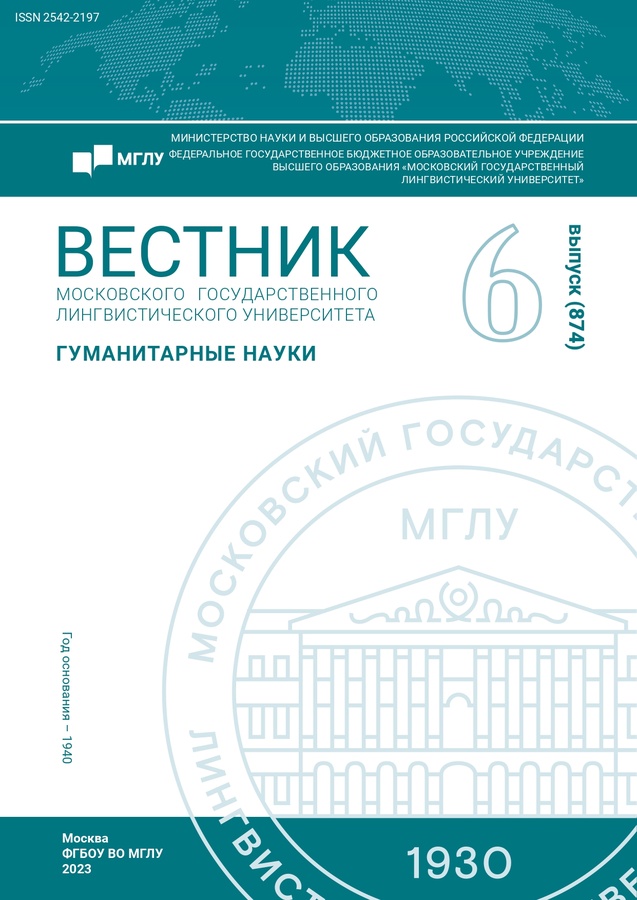Correlation Between Prosodic Means and Accentuating Gestures in Cross-Cultural Discourse (Gender Study)
- Authors: Gendelev I.D.1,2
-
Affiliations:
- University of Science and Technology MISIS
- Moscow State Linguistic University
- Issue: No 6(874) (2023)
- Pages: 49-55
- Section: Linguistics
- URL: https://journal-vniispk.ru/2542-2197/article/view/350914
- ID: 350914
Cite item
Full Text
Abstract
The article analyses the role of the gender factor in the correlation between prosodic means and accentuating gestures. The research is based on the speech of 14 General American respondents engaged in cross-cultural discourse. The results of auditive, visual, acoustic, and comparative types of analysis reveal gender-specific features of the correlation under study. Singled out differences in the male and female styles of communicative behaviour emphasise the significance of the issue in question.
About the authors
Ilya Dmitrievich Gendelev
University of Science and Technology MISIS; Moscow State Linguistic University
Author for correspondence.
Email: elijah011@mail.ru
Assistant at the Department of Foreign Languages and Communication University of Science and Technology MISIS; Postgraduate Student of the Department of English Phonetics, Moscow State Linguistic University
Russian FederationReferences
- Smirnova, E. V. (2005). Gender, Social and Cultural Peculiarities of Communication. Proceedings of Voronezh State University. Series: Linguistics and Intercultural Communication, 2, 131–138. (In Russ.)
- Kreidlin, G. E. (2003). Muzhchiny i zhenshhiny v dialoge I: neverbal’nye gendernye stereotip = Men and Women in Dialogue I: Nonverbal Gender Stereotypes (article). Komp’yuternaya lingvistika i intellektual’nye tekhnologii: trudy mezhdunarodnoi konferentsii «Dialog-2003» (11–16 iyunya 2003 g.) (pp. 337–345). Moscow: Nauka. (In Russ.)
- Klyukina, Yu. V. (2016). Gender kak social’no-kul’turnyj konstrukt = Gender as a Social-Cultural Construct. Sovremennoe obshhestvo i vlast’, 3(9), 417–436. (In Russ.)
- Ilina, E. (2018). Gender kak sociokul’turnyj konstrukt i ego rol’ v nauke o jazyke = Gender as Social and Cultural Construct and its Place in Linguistics. Teoriya i praktika lingvisticheskogo opisaniya razgovornoi rechi, 2(31), 86–91. (In Russ.)
- Birdwhistell, R. L. (1970). Kinesics and Context. Phildelphia: University of Pennsilvania Press.
- Lacoff, R. (1973). Language and Woman’s Place. Language in Society, 2, 45–79.
- Argyle, M. (1975). Bodily Communication. London, New York: Methuen and Co. Ltd.
- Bernard, L. C. (1981). The Multidimensional Aspects of Masculinity-Femininity. Journal of Personality and Social Psychology, 41, 797–802.
- Zemskaya, E. A., Kitaigorodskaya, M. A., Rozanova, N. N. (1993) Osobennosti muzhskoi i zhenskoi rechi = Features of male and female speech. Russkii yazyk v ego funktsionirovanii. Moscow: Academia. (In Russ.)
- Ivantsova, M. (1999). Gender peculiarities of interpersonal communication in adolescence. Zhenshhina. Obrazovanie. Demokratija. 2-ya mezhdunarodnaya mezhdistsiplinarnaya nauchno-prakticheskaya konferentsiya 3–4 dekabrya 1999. http://envila.iatp.bv/info/courses/conference99 (In Russ.)
- Pearson, J. C., Nelson, P. E. (2000). An Introduction to Human Communication: Understanding and Sharing (eighth edition). Boston: McGraw-Hill Higher Education.
- Cameron, D. (2007). The Myth of Mars and Venus: Do men and women really speak different languages? New York: Oxford University Press Inc.
- Garanovich, M. V. (2011). Variativnost’ gendernykh stereotipov v zavisimosti ot sotsial’nykh parametrov govoryashchikh = The variability of gender stereotypes depending on the social features of the speakers: PhD in Philology. Perm. (In Russ.)
- Kirilina, A. V. (2021). Gender and Gender Linguistics at the Border of the Third Millennium. Journal of Psycholinguistics, 3(49), 109–147. (In Russ.
- Hall, J. A. (1984). Nonverbal Sex Differences: Accuracy of Communication and Expressive Style. Baltimore ; London: The Johns Hopkins University Press.
- Cibulya, N. B. (2020). Study of nonverbal means of communication nonverbal means of communication by Russian scholars : Monograph. Moscow: Gnozis. (In Russ.)
- Klein, Z. (1984). Sitting postures in male and female. Semiotica, 48 (2), 119–131.
- Mehrabian, A. (1968). Relationship of attitude to seated posture, orientation, and distance. Journal of personality and social psychology, 10(1), 26–30.
- Gendelev, I. D., Tsibulya, N. B. (2023). Correlation between Prosodic Means and Accentuating Gestures in Crosscultural Communication (based on British and American cross-cultural discourse). Vestnik of Moscow State Linguistic University. Humanities, 1(869), 41–47. (In Russ.)
- Hall, E. (1969). The Hidden Dimension. New York: Anchor Books Editions.
Supplementary files










